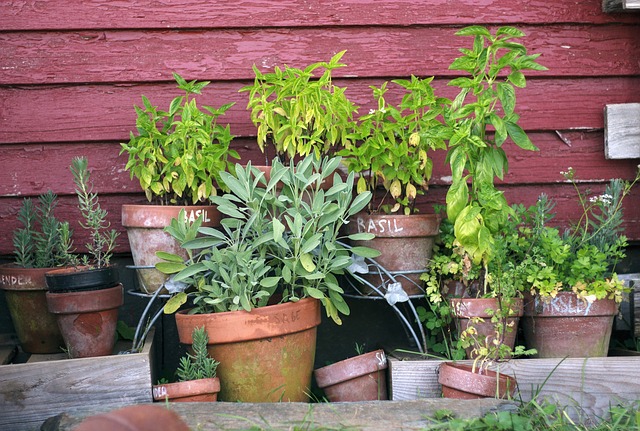Herb gardens don’t have to be boring. Use themes to provide fragrance, design, and a purpose for your yard. I’ve included 6 easy-themed herb gardens that will work well for small or large areas. They’re perfect for everyone from beginners to experienced herbalists. If you’re feeling ambitious and have lots of time, try a more complicated herb garden design like a formal garden designed after the formal English Gardens, a Shakespearan garden using herbs mentioned in the works of Shakespeare, or a literary garden using herbs mentioned in your favorite book, or a Biblical herb garden, featuring herbs featured in the Bible. For the rest of us, with not much time, try one of these.
6 Easy Themed Herb Gardens
I’ve included the scientific and common names of common, easy-to-find herbs in your favorite local nursery or garden center, along with some helpful hints I’ve learned the hard way, and their uses.
Tea Garden
These plants are often grown for their use in herbal teas. Experiment blending herbs when brewing tea to create your own unique flavors. Try any of these varieties in your garden.
Mint: -Perennial- (Mentha) There are several types of mint; all with unique flavors, that are essential for the tea garden. Spearmint (Mentha spicata), Peppermint (Mentha × piperita), Apple Mint (Mentha suaveolens), Chocolate (Mentha × piperita ‘Chocolate Mint’)
Avoid planting several types of mint together as they will cross pollinate.
Mint is invasive and will quickly spread across the garden. It is best grown in containers or carefully controlled.
Basil: –annual– (Ocimum basilicum) Try one of these speciality basils to add flavor and color to your garden. Cinnamon (Ocimum basilicum ‘Cinnamon’), Thai (‘thyrsiflorum’), Dark Opal (‘Purpurascens’)
Chamomile: Used for centuries to soothe tummies, Roman (Chamaemelum nobile) is a perennial, while the German variety (Matricaria recutita) is an annual.
Fennel: either of these varieties add striking background foliage; Florence fennel or Finocchio -( Foeniculum vulgare var. dulce) or Vegetable Fennel (“Foeniculum vulgare var. azoricum.”)
Lavender– Perennial–The most common type, known for its aromatic scent and lovely purple flowers is English (Lavandula-angustifolia.)
Lemon Balm– Perennial – (Melissa officinalis) This fragrant and tasty herb is a member of the mint family and can become invasive. Plant in pots to avoid spreading or keep the plant closely contained.
Bee Balm– Perennial (also known as bergamot-Monarda didyma) This native North American plant was used by colonists as a substitute for tea after the Boston Tea Party.)
Thyme: Perennial Try the Lemon (Thymus citriodorus) variety for a tea garden.
Lemon Grass– Tender Annual (Cymbopogon citratus, Stapf ) a lovely grass-type herb, it’s grown as an annual in most of the US.
Sage: (Salvia officinalis)- the common variety used in cooking, especially fall dishes. This variety is perennial. Use other annual varieties like pineapple sage for color and interest.
Culinary or Kitchen Herb Gardens
These are grown for their use in recipes and are best used fresh. To add color to the garden, add annual edible flowers like calendula (pot marigold) and nasturtium (Tropaeolum majus.)
Basil-annual- is used in Italian dishes, sauces, Asian curries, and meat dishes.
Chervil–Anthriscus cerefolium – annual- used in chicken, fish, vegetables, eggs, and salads.
Chives–allium schoenoprasum– perennial- used in eggs, fish, potatoes, salads, shellfish, and soups. One of the herbs in Herbes de Provence
Coriander (Cilantro) Coriandrum sativum– annual-is used in Mexican and Middle Eastern cuisine, as well as spicy Thai, Chinese, Vietnamese, Southeast Asian, and Indian cuisines.
Dill–Anethum graveolens- annual-used in fish, lamb, potatoes, and peas
Florence Fennel-perennial-used in soups, stews, seafood, roasted meats, and can be used in recipes that call for dill and parsley.
Marjoram –Majorana hortensis- perennial- use in salad dressings, meat dishes, and preserved meats, vegetables, tomato-based dishes, and poultry seasoning.
Oregano–Origanum vulgare- perennial- use in tomato recipes, olive oil-based dishes, Italian vinaigrette, and marinades for lamb, chicken, and beef dishes.
Mint-perennial- is used in teas, desserts, Asian dishes, and with lamb.
Parsley– Petroselinum crispum-perennial- is used in stews, soups, sauces, Italian and Mediterranian dishes. Do not plant near fennel or mint.
Rosemary–Rosmarinus officinalis- perennial- used in meats, poultry, casseroles, stews, and soups.
Sage -perennial-used in meats, vegetables, stuffing, teas, and sauces
Thyme-perennial- used in European, Middle Eastern, North African, Mediterranean, Italian, and Provençal French cuisines. Pair it with lamb, poultry, and tomatoes. Thyme is often added to soups and stews.
Feeling Adventurous? Divide the culinary garden into “specialty” gardens. Here’s some fun ideas sure to provide recipe inspiration.
Pizza and Pasta Garden: oregano, thyme, basil, fennel, parsley
French Cuisine: Chervil, Fennel, Marjoram, Tarragon, Thyme
Salad Bar: Italian Flat leaf parsley Lemon and Garden Thyme, Chives, Genovese basil, Cilantro, Chervil, Peppermint, and Savory.
Pollinator Garden
These plants attract beneficial pollinators like bees, butterflies, and hummingbirds. To attract pollinators, plant at least five of each type of plant used and place identical plants together. Use any of these herbs in your pollinator garden.
Rosemary-perennial- attracts mason, bumble, mining, and honey bees, nectar-feeding flies, and butterflies.
Catmint -Nepeta racemosa- perennial–attracts honey bees and hummingbirds, butterfly and moth larvae.
Borage– Borago officinalis -annual- attracts bees, butterfly larvae, butterflies, hoverflies
Thymes -perennial-attracts native bees and parasitoid wasps.
Catnip –Nepeta cataria-perennial-attracts bees and butterflies. This can be invasive and attract cats.
Chives-perennial- attracts bees and some butterflies
Chamomile-perennial- attracts hoverflies, beneficial wasps, ladybugs, and honey bees
Sage-perennial–attracts bees, butterflies, hummingbirds
Fennel -perennial-attracts bees, butterflies, butterfly larvae, and hoverflies
Basil -annual- the blooming flowers attract bees
Mints -perennial-any variety- attracts earthworms, hoverflies, bees, and predatory wasps
Lemon balm –Melissa officinalis- perennial– attracts bees, butterflies, and hummingbirds
Bee balm– perennial- attracts bees, butterflies, including Monarchs, hummingbirds, and hummingbird clearwing moths
Parsley-biennial- attracts hoverflies, predatory wasps, and Bluefly larvae when flowering.
Dill-annual-attracts Lacewings, ladybugs, hoverflies, braconid wasps, tachinid flies, and butterfly larvae
Lavender-attracts butterflies and hummingbirds
Oregano-attracts butterflies, lacewings, and bumblebees.
Pest Repellent Garden
Provide fragrance and repel pests? It is possible. Herbs said to repel pests include the following:
Basil -annual- repels flies, mosquitoes,, carrot flies, asparagus beetles, and whiteflies
Lemongrass,-annual-repels mosquitos
Mint -perennial-repels cabbage moths, aphids, mosquitos, and flea beetles.
Oregano– perennial-repels cabbage moths
Marjoram-perennial- repels cabbage moths
Lavender-perennial-repels moths, fleas, flies, and mosquitoes
Rosemary-perennial-repels cabbage moths, Mexican bean beetles, carrot rust flies, flies, and mosquitoes.
Thyme-repels whiteflies, cabbage loopers, cabbage maggots, corn earworms, whiteflies, tomato hornworms, and small whites. Lemon Thyme is said to repel mosquitos.
Sage-perennial-repels snails, cabbage moths, beetles, black flea beetles, carrot flies, and flea beetles.
Catnip-perennial-repels mosquitoes, flies, deer ticks and cockroaches, ants, flea beetles, aphids, Japanese beetles, squash bugs, weevils, the Colorado potato beetle, and the cabbage looper. Could attract cats.
Chives– perennial-repels carrot flies, Japanese beetles, and aphids.
Citronella– annual-repels mosquitos
Parsley-biennial- repels asparagus beetles
Fennel– -perennial-repels aphids, slugs, and snails.
Lemon Balm-perennial- repels mosquitos
Note: I have all these plants in my garden and am still bitten by mosquitos.
Aromatherapy Herb Garden:
These herbs are prized for their fragrance, especially when brushed against when walking through the garden. They are often used in essential oils, homemade scrubs, and bath products.
Rosemary -perennial- has a strong pine and lemon aroma and is used in aromatherapy as an air purifier or an infusion for hair
Basil– annual- has a strong bitter aroma with hints of cloves and licorice. It is used in aromatherapy as an air purifier or insect repellent
Lavender- perennial-has a rich, floral aroma and is used in aromatherapy in essential oils, bath products, and linen spray.
Lemon Balm-perennial -has an aroma with a mixture of lemon and mint. It is often used as a fragrance in candles.
Peppermint -perennial-has a strong menthol aroma and is often used in essential oils and bathing products.
Catmint -perennial- has a sage-like smell and is often used in essential oil.
Bergamont (Beebalm)- perennial-has a spicy, minty aroma and is often used in body wash, scrubs, and shampoo.
Chamomile– annual or perennial, depending on variety-has a sweet, apple-like aroma and Is often used in lotions, perfumes, bath gels, and bath oils.
Lemon Grass– annual- has a strong, lemon scent with earthy undertones and is often used as a massage oil.
Marjoram – perennial- has a woody, herbal scent and is often used in linen spray.
Sage -is a perennial or annual, depending on the variety. Its aroma is similar to mint but more earthy and is sometimes used in air purifiers and hair infusions.
Thyme– perennial -several varieties have a minty or lemon aroma. Thyme can be used in potpourri.
Children’s Herb Garden
A great way to interest children in gardening is to let them help design their own area. Choose edible and fragrant herbs varieties along with edible flowers. Good herbs to use are:
Lavender-perennial- has a strong fragrance and can be used in desserts and teas.
Creeping thyme– perennial- has a lovely fragrance, can be used in cooking, and, when established, can be walked on occasionally
Lemon balm– perennial- has a lovely fragrance and can be used in cooking.
Mints- perennial- has a lovely fragrance and can be used in cooking and teas.
Parsley– biennial- the curled variety adds a fun shape and texture to the garden
Factors to consider when Planting Themed Gardens
Cost: The price of plants is increasing. Don’t think you need to plant the entire list of herbs in your garden. Start with two to three varieties and add more as you can afford them.
Light: Most herbs need full sun (at least 6 hours of daily.)
Soil: Most herbs prefer fertile, well-drained, weed-free soil with a pH of 6 to 7.
Water: The soil needs to be moist but not wet. Most herbs require around 1” of water per week. Depending on soil conditions, herbs need to be watered daily or weekly. Test the soil’s dryness by sticking your finger into it. If the top inch is dry to the touch, water the garden.
Size: Space plants properly to avoid overcrowding and diseases. Take into account the size the herb will be when matured.
Fertilize: most herbs monthly.
Prevent diseases and fungal issues by not splashing water on the leaves during irrigation.
Don’t use pesticides on herbs you plan to consume.
I hope this helps you start the herb garden of your dreams. Believe me, once you start, it’s contagious. You’ll want to plant more and expand your garden. Do you have a themed garden? What are some of your favorite herbs to grow and how do you use them?
You Might Like These Posts:
How to Grow Chives and Culinary Uses
How to Grow Parsley and Culinary Uses
How to Grow Basil and Culinary Uses














